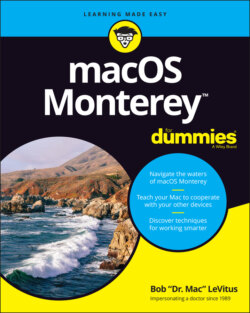Читать книгу macOS Monterey For Dummies - Bob LeVitus - Страница 34
Shuffling windows
ОглавлениеI’ve already spent plenty of pages giving you the scoop on how to work with windows. But wait. There’s more! The commands on the Window menu provide tools you can use to manage your windows.
Here is a brief look at each of the items on the Window menu. (And if you’re unfamiliar with menus and keyboard shortcuts, you find out how they work later in this chapter.)
Minimize (⌘ +M): Use this command to minimize the active Finder window to the dock and unclutter your desktop. It’s the same as clicking the yellow gumdrop button.
Zoom: This command does the same thing as the green gumdrop button. If you’ve forgotten what the green gumdrop does already, just turn back a few pages to the “Top o’ the window to ya!” section and read it again.
Tile Window to Left Side of Screen: Invokes Split Screen mode and moves the active window to the left half of the screen.
Tile Window to Right Side of Screen: Invokes Split Screen mode and moves the active window to the right half of the screen.You may see additional options to move the window to a different device (such as an iPad) via Sidecar when a suitable device is close enough to your Mac (see Chapter 27).
Cycle through Windows (⌘ +`): Each time you choose this command or use the keyboard shortcut for it, a different window becomes active. So if you have three windows — call ’em Window 1, Window 2, and Window 3 — and you’re using Window 1, this command deactivates Window 1 and activates Window 2. If you choose it again, the command deactivates Window 2 and activates Window 3. Choose it one more time, and it deactivates Window 3 and reactivates Window 1.
The next four commands in the Window menu help you manage Monterey Finder window tabs. If you’re a fan of tabbed browsing (à la Safari), you’ll love tabs in a Finder window.
Tabs let you view multiple folders or disks or both in a single window, with each folder or disk in its own tab, as shown in Figure 2-5.
Tabbed windows are an ingenious way to cram a lot of information into a little space. I’ve tried a number of third-party utilities that purported to provide tabbed Finder windows, but I’ve never found one that’s reliable and robust enough to continue using. This one, on the other hand, just works.
FIGURE 2-5: I can view the contents of my Documents (shown), Applications, or Downloads folder by merely clicking the appropriate tab.
Monterey, like its last few predecessors, includes system-wide tabbed windows, which should work in almost every application that uses windows. The cool part is the app doesn’t have to be updated in any way — Monterey grafts tabbed windows onto almost every app that displays multiple windows.
The remaining commands in the Window menu are as follows:
Show Previous Tab (Control+Shift+Tab): Each time you choose this command or use its keyboard shortcut, the previous tab — the one to its left, unless it’s the leftmost tab — becomes active. For example, in Figure 2-5, Documents is the active tab. Use this command, and Applications becomes the active tab. Use it a third time, and Downloads becomes active. Because Downloads is the leftmost tab, if you use this command yet again, it wraps around and Documents becomes the active tab again.
Show Next Tab (Control+Tab): Same as Show Previous Tab except in reverse. Instead of showing the previous tab (the one to the left), this command shows the next tab (the one to the right). Use this command three times in a row (refer to the order shown in Figure 2-5), and you see the Downloads tab, then the Applications tab, and finally the Documents tab again.
Move Tab to New Window (no keyboard shortcut): Does just what it says; it moves the active tab into a new window of its own.
Merge All Windows (no keyboard shortcut): Combines all open windows and tabs in one window. You can click a tab and drag it left or right to change the order. You can also drag and drop a tab from one Finder window to another. The trick is to click directly on a tab and drag it onto the tabs in the target window. If you release it anywhere else, the tab will be displayed in a new window.One more thing: In Monterey, all these commands and keyboard shortcuts appear in most apps that display windows.
Bring All to Front (no keyboard shortcut): Windows from different applications can interleave. For example, you can have (from front to back) a Finder window, a Microsoft Word window, an Adobe Photoshop window, another Microsoft Word window, and another Finder window. In this example, choosing Bring All to Front while Finder is the active application enables you to have both Finder windows move in front of those belonging to Word and Photoshop. If you want to bring all the windows belonging to Finder (or any other program, for that matter) to the front at the same time, you can also click the appropriate dock icon (Finder, in this case).If you hold down the Option key when you click the Window menu, Minimize Window changes to Minimize All, and the Zoom command changes to Zoom All.
Other items: The remaining items on the Window menu — if any — are the names of all currently open Finder windows. Click a window’s name to bring it to the front.
